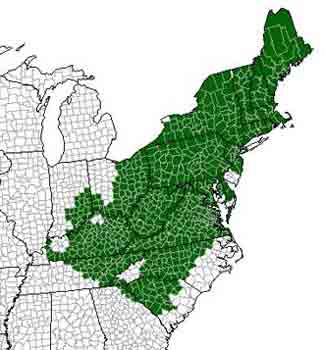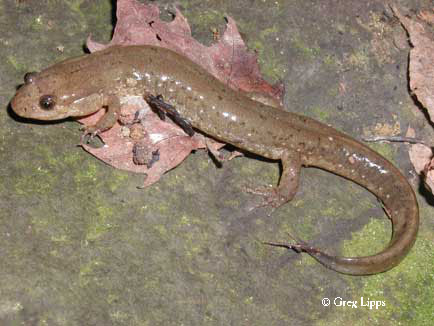
Northern Dusky Salamander
(Desmognathus fuscus fuscus)
 |
 |
|
|
Distribution of the Northern Dusky Salamander (from the AR MI Atlas)
|
An adult Northern Dusky Salamander.
|
|
Description: One of the most variable patterned salamanders in Ohio, adult Northern Dusky Salamanders are usually yellowish brown to dark brown. Five to eight yellow dorsal spots bordered by a dark band are present on juveniles, and some remnants of these markings may or may not be present in adults. The underside is lightly mottled with a mixture of gray or brown. As with other members of this genus, a light line extends from the eye to the angle of the jaws. |
||
Distribution in Ohio: Mainly south and east of a line from Cincinnati to Cleveland. |
||
|
|
||
Status in Ohio: Locally abundant and widespread. |
||
|
|
||
Habitat: Small streams, seeps, and springs, where it lives under rocks, logs, or leaf litter within or adjacent to shallow water. |
||
|
|
||
Life history: A compact cluster of 12-27 eggs is laid under a rock near water in late July. Females remain with the eggs until hatching in September. The aquatic larvae complete metamorphosis the following summer and begin breeding 2-3 years later. |
||
|
|
||
Conservation: Populations of Northern Dusky Salamanders are most threatened by destruction, disturbance, or pollution of their small aquatic habitats, including streams and seeps. Pollution, runoff, and stream channelization and scouring are all major threats to these habitats in Ohio. Removal of forests around streams and seeps increases siltation, water temperature, and evaporation, and alters the prey base and foraging opportunities for the species. |
||
Last modified:
|
Ohio Amphibians · Ohio Salamander Web · Ohio Salamander Species · Amphibian Habitats · Salamander Monitoring |
|